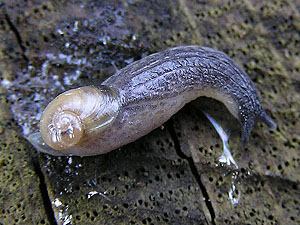
The reddish daudebardia (Daudebardia rufa), an underground
hunter feeding on earthworms Quelle: biolib.cz (Jiří Novák).
| Part I: Basics, Herbivorous and Carrion Eating Land Snails | Part II: Carnivorous Land Snails | Part III: Sea Snails and Slugs |
 The reddish daudebardia (Daudebardia rufa), an underground hunter feeding on earthworms Quelle: biolib.cz (Jiří Novák). |
European predatory snails, for example, are the Daudabardias and Testacellas (a.k.a. shelled slugs), usually almost unknown outside of scientific circles, since they live subterraneously. In Great Britain, another species has only been discovered in 2006 and also belongs to a group otherwise not present in Europe, the Trigonochlamydidae:
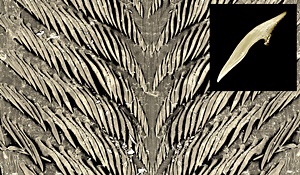 Radula and single radula tooth of Selenochlamys ysbryda. EM-Picture: National Museum Wales (Source). ( |
![]() Welsh Ghost Snail (Selenochlamys
ysbryda).
Welsh Ghost Snail (Selenochlamys
ysbryda).
What is quite spectacular, are those snails' radula teeth: long and sharp, they are used to grab the prey, usually earthworms, and to pull it into the mouth, even with the worm resisting.
While the predatory snails mentioned so far are so-called semi-slugs (see: Shell reduction in snails) - their shell has been reduced to a clam-like shell rest to the advantage of better movability - there are also complete slugs that eat other snails. Among those, there is the leopard slug (Limax maximus), as well as the worm slug (Boettgerilla pallens), which belongs to a related group of snails (see: Terrestrial Mollusc Tool: Boettgerilla pallens).
But also among the European regular snails, there are numerous carnivorous species: Many gloss snails (Aegopinella and Oxychilus), but also the tiny glass snails (Vitrinidae). The latter have developed an interesting hunting method: They are less susceptible to cold than other land snails, which means they only have to wait until the others start to hibernate to start feeding on them. Thankfully, glass snails only reach a few centimetres in size.
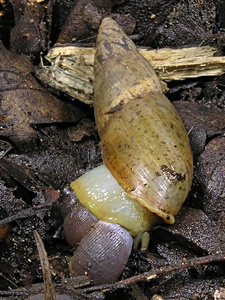 Sicilian predator snail (Poiretia dilatata) feeding on Pomatias elegans. |
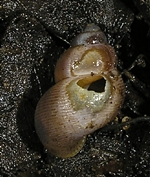 Acid damage by Poiretia on the shell of a Pomatias elegans. Pictures: Fabio Liberto. |
Another interesting hunting technique has been adopted by the Dalmatian predator snail (Poiretia cornea), which can be found on the Adriatic coast from Monfalcone in northeastern Italy as far as southern Albania. Another relative is the Sicilian predator snail (Poiretia dilatata).
The preferred prey of those predator snails are round-mouthed snails of the genus Pomatias. Since this kind of snail has a shell lid (operculum) to protect the aperture of its shell, the predator cannot enter the shell there to eat the inhabitant. Instead, it has developed an acid gland in its foot (which secretes mucus enriched with carbon dioxide and thus acid). Using this acid secretion, the predator dissolves the prey's shell wall and eats the snail.
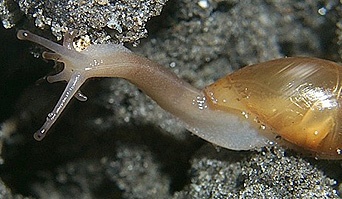 Rosy wolf snail(Euglandina rosea),juvenile specimen. Picture: Bill Frank, Jacksonville Shell Club. |
|
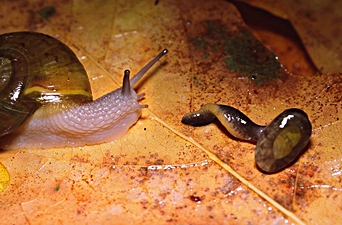 Robust lancetooth (Haplotrema vancouverense, left) and dromedary jumping slug (Hemphillia dromedarius, right). Picture: Kristiina Ovaska (Source). |
![]() Forum Natura
Mediterraneo:
La Predazione di Poiretia.
Forum Natura
Mediterraneo:
La Predazione di Poiretia.![]() Walter Pfliegler:
Youtube Video of Poiretia cornea from Kroatien.
Walter Pfliegler:
Youtube Video of Poiretia cornea from Kroatien.
Systematically, Poiretia is part of the Oleacinidae family (though that is contested), a family of exclusively carnivorous land snails, distributed at home in the Neotropic zone (see: Faunal provinces). With the exception, of course, of the Poiretia genus, which live, with six species and another related one in Sardinia, in the Mediterranean and the Caucasus, being the only members of the Oleacinidae family living outside the Neotropic. They are also related to the aforementioned shelled slugs (Testacellidae), with which they are placed in the Testacelloidea superfamily.
Despite its flowery name, the rosy wolf snail (Euglandina rosea) is not a peaceful creature either: Its lips are elongated to form a third pair of tentacles, so it can better track and follow its prey - usually smaller land snails - along their slime thread. When hunting its prey, Euglandina will not stop from crossing water and climbing trees. Larger snails are eaten piecemeal, smaller ones whole, their shell included. The young already feed on eggs or their smaller siblings and thus grow stronger.
On the islands of French Polynesia, the wolf snail has been introduced to deal with the likewise introduced giant African land snails (Achatinidae), which had escaped from human farms, where they had been kept as food source.
The wolf snail, however, rather tends to hunt smaller tree snails than the giant African snails, which led to the extinction of several of the small endemic land snail species (e.g the Partula genus).
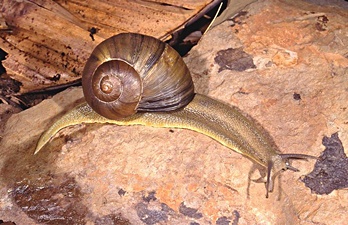
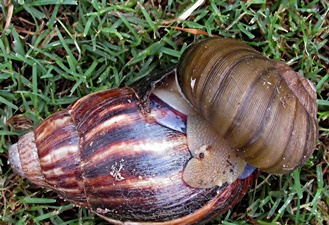 Picture left: Natalina cafra. Picture: Dai Herbert. Source: Herbert, Moussalli (2010). Picture right: Natalina cafra feeding on Archachatina marginata in South Africa. Picture: P. Vos (Source). |
Another non-European carnivorous snail species is the lancetooth snail. The robust lancetooth (Haplotrema vancouverense) is found in the northeastern United States and in Canadian British Columbia and mainly hunts smaller slug species. Those on the contrary have developed an interesting method to evade an attacker. They get out of harm's way by flapping their tail and winding their bodies, until they jump out of their predator's reach. This is why those slugs are also called jumping slugs.
| Jumping slugs (Hemphillia). | |
|
|
Mollus.ca: Haplotrema (Ancomena) vancouverense (I. Lea, 1839) - Robust Lancetooth. |
On the other hand, from eastern and southeastern South Africa Natalina cafra (Rhytididae family) is known. In this snail it can well be seen, how long and slender the snail's frontal body is, so the snail can well reach into its prey's body. The shell's final whorl is also quite wide, so the predator can eat smaller snails in whole. Contrary to the rosy wolf snail (Euglandina rosea), Natalina cafra (also known as the common cannibal snail, since it also feeds on its own kind) has no problems attacking giant African land snails (Achatinidae). To be fair, Natalina cafra is also noticeably larger than the slender wolf snail, its shell growing to a width of 73 mm and a height of 50 mm.
In New Zealand, there are other Rhytididae snails: The large Powelliphanta snails are nocturnal and mainly hunt for earthworms and slugs, which they grab with their radula, then pull them into their mouth to be digested. On the other hand, many snails of the Powelliphanta genus in New Zealand are also endangered because they are preyed upon, mostly by introduced marsupials and mammals. Also the destruction of their habitats has a harmful impact on those snails.
| Jonathan Wojcik: Ghastly Gastropoda: Top Ten Predatory Slugs and Snails. | |
|
|
Wikipedia: Natalina cafra (in German, no English version available). |
|
|
Wikipedia: Powelliphanta. |
|
|
BBC Earth: Rare giant snail devours an earthworm. YouTube Video. |
|
|
Herbert, D., Moussalli, A. (2010): Revision of the larger cannibal snails (Natalina s. l.) of southern Africa — Natalina s. s., Afrorhytida and Capitina (Mollusca: Gastropoda: Rhytididae). African Invertebrates Vol. 51 (1), pp. 1–132. (Link, abgerufen 09.09.2022). |
|
|
Herbert, D., Kilburn, D.: Field Guide to the Land Snails and Slugs of Eastern South Africa. Natal Museum, Pietermaritzburg 2004. |
|
Barker, G.M.; Efford, M.G.: Predatory Gastropods as Natural Enemies of Terrestrial Gastropods and Other Invertebrates. In: Barker, G.B. (Ed.) (2004): Natural Enemies of Terrestrial Molluscs. CABI Publishing; p. 279 ff. |